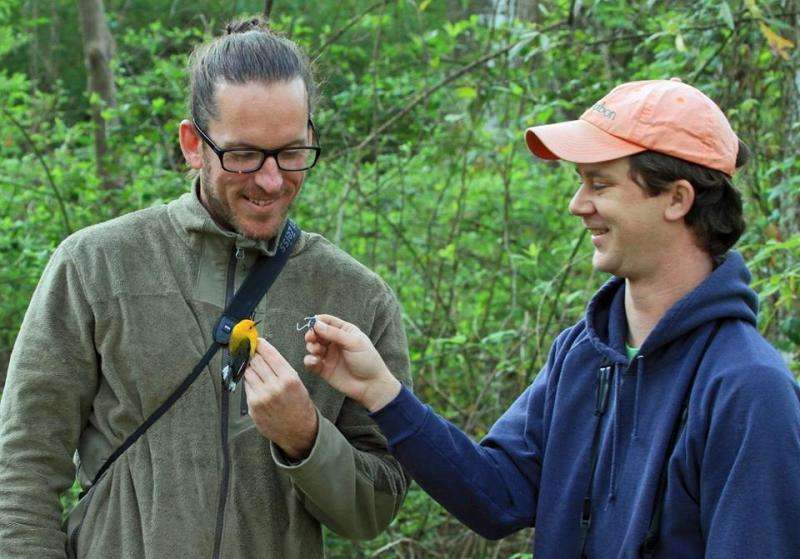Geolocators used to link breeding and wintering populations of Prothonotary Warblers

Prothonotary Warblers are stunningly beautiful and highly migratory birds closely tied to their preferred breeding habitat: swamps and other forested wetlands in the eastern United States. Scientists have noted that Prothonotary Warbler populations have experienced precipitous declines in recent years, prompting new research investigating the little known migratory behavior of this remarkable bird. As part of this effort, researchers from the U.S. Forest Service Pacific Southwest Research Station, Klamath Bird Observatory, Louisiana Bird Observatory, and Audubon Louisiana attached several geolocators—ultra-lightweight devices that record the time of sunrise and sunset each day—using a back-pack harness on several Prothonotary Warblers to identify their migratory routes and core wintering areas. The information collected by each geolocator was used to estimate the daily longitude and latitude of the bird.
"As part of this study, we deployed three geolocators on Prothonotary Warblers in Louisiana," says Jared Wolfe, lead author and postdoctoral researcher with the Pacific Southwest Research Station. "After the breeding season, at least one individual completed its fall migration, over-wintered and made its way back to Louisiana where the bird was recaptured and the geolocator was retrieved."
Data from the geolocator suggest that this bird traveled at least 5,000 miles through seven countries.
Researchers found that this Prothonatory Warbler's migration pattern included an initial flight over the Gulf of Mexico from Louisiana into Central America, then east to the Greater Antilles for about one month, followed by a flight over the Caribbean Sea south to northwest Columbia where it remained for the duration of the winter. These findings contribute to a growing body of evidence that many migratory birds often use two or more wintering locations, or exhibit prolonged stopover behavior.
"Our results are the first to document movements of Prothonotary Warblers during their migratory and over-wintering periods," says Erik Johnson, co-author of the study and director of bird conservation at Audubon Louisiana. "Based on the success of this study, we formed a coalition that includes researchers from Virginia Commonwealth University and Audubon South Carolina where we deployed an additional 47 geolocators on Prothonotary Warblers in 2014."
By increasing the breadth of the study, the team of scientists hopes to better understand the migratory and over-wintering behavior of Prothonotary Warblers to identify core areas of habitat that may require additional protection for the species. This study also demonstrates that geolocators can be safely used to document migratory connectivity of species of conservation concern.
The findings of this study were published in the September 2015 issue of the Journal of Field Ornithology.
More information: www.treesearch.fs.fed.us/pubs/49289
Provided by USDA Forest Service


















